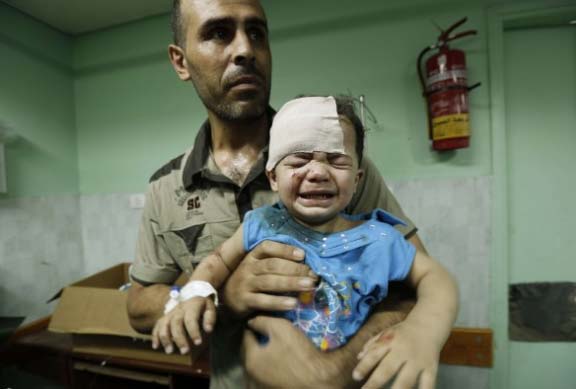Inside a Gaza Strip mosque in January 2009, nothing at first seemed unusual with the wooden pulpit pushed against the cement wall. Barely taller than a man, it stood beside a microphone stand near an electric fan and some plastic chairs, according to photographs captured by the Israel Defense Forces.
But hidden inside the pulpit, Israel alleged, were a Kalashnikov assault rifle, a bulletproof vest and binoculars. Soldiers soon spread the mosque’s cache on the floor, a haul that included a rifle, grenades and ammunition. Hamas operatives, Israel charged, were to blame.
“The many mosques in the Gaza Strip serve not only religious functions, but are also put to military use by Hamas and other terrorist organizations,” the Meir Amit Intelligence and Terrorism Information Center said at the time. “They are used to hide terrorist operatives, store weapons, as sites from which rockets and mortar shells are launched.”
To many observers, one of the most troublesome facts of the Gaza Strip conflict – which has killed around 1,340 Palestinians, many of them civilians, and 56 Israeli soldiers – has been Israel’s apparent willingness to strike civilian institutions such as mosques, schools and hospitals. On Wednesday, following a strike on a school while its inhabitants slept, killing 20 people and wounding dozens more, a United Nations official said Israel had violated international law. “I condemn in the strongest possible terms the serious violation of international law by Israel forces, said U.N. official Pierre Krähenbühl. “This is an affront to all of us, a source of universal shame. Today the world stands disgraced.”
Israeli military officials, for their part, say the reality of the strikes is substantially more complicated and claim Hamas’s maintenance of military operations inside civilian institutions precipitate such attacks.
“Hamas chooses to use these protected areas for military purposes in order to shield itself from IDF strikes,” the Israel Defense Forces said this week. “And to draw international condemnation of Israel if the IDF is forced to respond.”
The United Nations has found troves of rockets hidden in three of its schools since the conflict began. “We condemn the group or groups who endangered civilians by placing these munitions in our school,” Chris Gunness, spokesman for the U.N. Relief and Works Agency, said in statement published Wednesday by the Times of Israel. “This is yet another flagrant violation of the neutrality of our premises. We call on all the warring parties to respect the inviolability of U.N. property.”
Earlier this month, the United Nations also found rockets piled inside one of its vacant schools – near other schools used to accommodate displaced people.
The international organization also found 20 additional rockets at another of its schools during an inspection, calling it one more “flagrant violation of the inviolability” of the premises.
Israeli officials were quick to seize upon the discoveries, according to the Times of Israel, which quoted one official as castigating “Gaza terrorists [who] abuse facilities to carry out their violent activities.”
During one short-lived lull in rocket fire, The Washington Post’s William Booth saw a “group of men” at a mosque in northern Gaza. They said they had returned to clean up glass from shattered windows. “But they could be seen moving small rockets into the mosque,” Booth wrote. He also reported that Shifa Hospital in Gaza City had “become a de facto headquarters for Hamas leaders, who can be seen in the hallways and offices.”
Wall Street Journal reporter Nick Casey tweeted an image of a Hamas spokesman giving an interview at a Gaza hospital. With the shelling, “You have to wonder… how patients at Shifa hospital feel as Hamas uses it as a safe place to see media.” The tweet was later deleted.
According to longtime Middle East analyst Matthew Levitt, Hamas has long planted weapons in areas inhabited by vulnerable residents. “It happens in schools,” he wrote in Middle East Quarterly. “Hamas has buried caches of arms and explosives under its own kindergarten playgrounds,” referencing a 2001 State Department report that said a Hamas leader was arrested after “additional explosives in a Gaza kindergarten” were discovered.
For years, Hamas has “planned carefully for a major Israeli invasion,” according to a Washington Institute for Near East Policy report. In addition to an elaborate tunnel system, there was the “integral use of civilians and civilian facilities as cover for its military activity; schools, mosques, hospitals, and civilian housing became weapons storage facilities, Hamas headquarters, and fighting positions… IDF imagery and combat intelligence revealed extensive use of civilian facilities.”
Whatever its plan, the outcome of this practice is indisputably devastating – both in Palestinian lives lost and Israel’s standing in the international community. As images of death and tragedy clog news outlets, international condemnation of Israel mounts. Which, according to the Israeli military, is exactly what it predicted would happen.











